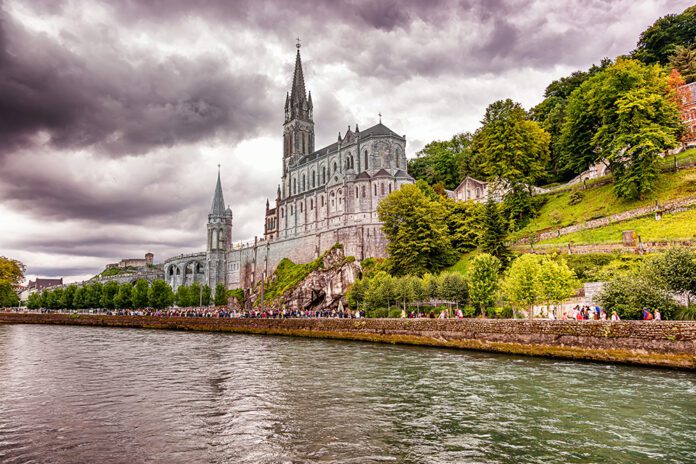Lourdes, France is home to one of the most miraculous Marian shrines. Its vast complex holds three basilicas. Each one holds significance to St. Bernadette’s mission and journey to sainthood.
A simple girl who struggled to retain her catechism, Bernadette Soubirous stands as a model of hope. Born on January 7, 1844, she was the first child of Francois Soubirous and Louise Casterot.
She helped her Aunt Bernarde, so she was unable to attend school. Bernadette would finally learn to read and write at the age of sixteen. It was in this simple life that Bernadette grew up. Jesus united Himself to her in Holy Communion on June 3, 1858, for the first time. It was from there that Bernadette would experience the touching love of His mother.
While searching for firewood, Bernadette came across a vision that would alter her life. Wind and light alerted her senses, although her companions seemed unbothered. A small woman dressed in white created questions in this uneducated maiden.
Bernadette would speak to this woman who asked for penance. The lady in her vision instructed Bernadette to drink from a spring and eat the herbs near it. From there, the Lourdes Spring erupted, which still heals pilgrims to this day.
The thirteenth apparition revealed more of this great mystery. The lady answered Bernadette’s question as to who she was. She answered, “Que soy era Immaculada Concepciou — I am the Immaculate Conception.”
Consecrated on July 1, 1876, the Basilica of the Immaculate Conception bears this inscription in Lourdes, France. It proudly stands as an answer to Our Lady’s request for a chapel. The giant gold crown in its courtyard reminds pilgrims of Mary’s Heavenly Queenship and intercession.
This glorious basilica is not the only one to grace Lourdes’ vast property. The Basilica of Our Lady of the Rosary designed in the Romano-Byzantine style further attests to Our Lady’s intercession. Consecrated on October 6, 1901, the mosaics inside represent the mysteries of the Rosary. Each one is meticulously designed to honor the Blessed Mother.
St. Pope John Paul II initiated the Luminous Mysteries in 2002. In 2008, these were added into the basilica. In his encyclical, Rosarium Virginis Mariae, the now saint stated, “The Rosary, though clearly Marian in character, is at heart a Christocentric prayer.” In contemplating the beautiful mosaics within the Basilica of Our Lady of the Rosary, one is captivated by God’s love.
The holy pontiff continued, “With the Rosary, the Christian people sit at the school of Mary and [are] led to contemplate the beauty of the face of Christ and to experience the depths of His love.” This basilica with its byzantine flair brings heaven to earth. It exemplifies Our Lady’s role in Christ’s life and in salvation history testifying to the unconditional love God and His mother have for mankind.
1958 marked the 100th anniversary of the Lourdes’ apparitions. It was this year that led to the construction of the third basilica — the underground Basilica of St. Pius X. Its pre-stressed concrete demonstrates modern architecture’s design and capabilities. Inside, it resembles a boat reminding pilgrims of their own faith journeys and final destination — heaven.
After the apparitions ceased, Bernadette lived quietly in the Nevers convent as Sr. Marie-Bernard. She never returned to the Lourdes Grotto. Still, her heart remained there as she continually offered up penances. She helped in the convent’s infirmary and often found herself a patient there due to her poor health.
On April 16, 1879, the thirty-five-year-old visionary breathed her last. Her “work of prayer” and “living crucified” had finally ceased. Later, her body would be found incorrupt. Finally, on December 8, 1933, the simple Bernadette Soubirous was canonized. Her calling reminds us that no matter how small we are, Our Lady can do great things with us for her Son’s glory.

